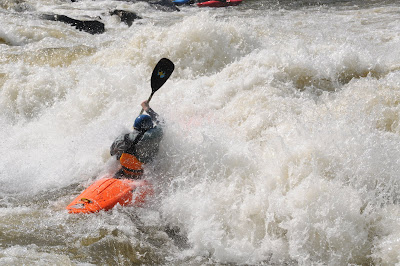Before you even begin building a boater first aid kit ask yourself what the most likely types of injuries you’ll encounter are. Your answer to this question will determine what you pack in your first aid kit. Remember, you only have limited space – there’s not enough room for everything. Also, pack with others in mind. You may not be diabetic, but chances are somebody else on the river is, so cake icing would be a valuable addition to your kit.
The most common injuries we see are: sprained ankles, pulled muscles, head lacerations (remember to tuck), dislocated shoulders, and dehydration. With that in mind, here’s a very small, but effective, kit equipped to handle the aforementioned emergencies.

1.Sam splint: Great for stabilizing sprained ankles, or broken bones
2.Crevats: These triangular pieces of cloth can be used for slinging a dislocated shoulder, or wrapping a wound
3.Roller Gauze: Dip it in a little iodine water to create a wet dressing, or use it to wrap a wound
4.Gauze packets: to stop the bleeding
5.Band-aids and butterflies
6.Tape
7.Matches (to warm people up)
8.CPR mask
9.Gloves
10. Ace wrap
11. Ibuprofen/Aspirin, Benadryl (for those allergic to bee stings, etc), Cake Icing (for diabetics), Oral potassium/salt (for dehydrated people that can’t keep water down), iodine (for purifying water or cleaning wounds – when cleaning wounds dilute the iodine)
Having a first aid kit is only the first step. Knowing how to use it or administer aid is the second step. We offer advanced wilderness first aid courses as well as wilderness first responder courses here at NOC. Even if you don’t take a course with us, we strongly encourage all boaters to take a first aid course somewhere - preferablly a wilderness course.

 The adventure started at the Nanthala Cascades. After a big rain we figured they'd be running. Of course they weren't, which didn't stop us from banging our way down them anyways
The adventure started at the Nanthala Cascades. After a big rain we figured they'd be running. Of course they weren't, which didn't stop us from banging our way down them anyways . We did a few laps and bruised and battered we made our way back to NOC around nine o'clock. One of the instructors suggested we drive to West Virginia. Being that we all had two days off it sounded like a great idea. We met at Arby's at 11 pm, loaded the boats, and started the trip north.
. We did a few laps and bruised and battered we made our way back to NOC around nine o'clock. One of the instructors suggested we drive to West Virginia. Being that we all had two days off it sounded like a great idea. We met at Arby's at 11 pm, loaded the boats, and started the trip north. We drove through the night and made it to the West Virginia Visitor's Ce
We drove through the night and made it to the West Virginia Visitor's Ce nter around 5am the next morning. We slept in the parking lot for two hours until the rangers showed up and started leaf-blowing right by our heads. Barely awake we pressed on to the put-in for Mann's Creek. It was on the low side of doable, but still very fun.
nter around 5am the next morning. We slept in the parking lot for two hours until the rangers showed up and started leaf-blowing right by our heads. Barely awake we pressed on to the put-in for Mann's Creek. It was on the low side of doable, but still very fun. It went pretty well, considering we were paddling boats loaded down with camping equipment and hotdogs. Lost Paddle was also exciting, but not as exiting as Sweet's Falls which had a hole as big as train in it. We snuck that one. We continued to paddle down through the Middle Gauley and a few miles into the Lower. We spent a lot of time surfing holes. Sometimes the holes spent a lot of time surfing us. After a tasty meal of s'mores, hotdogs, and vegetable stirfry we fell asleep in the dirt somewhere below Five-Boat Hole. The next morning we finished the paddle out on the Lower and arrived at the takeout at 11am for the long drive back to Bryson City.
It went pretty well, considering we were paddling boats loaded down with camping equipment and hotdogs. Lost Paddle was also exciting, but not as exiting as Sweet's Falls which had a hole as big as train in it. We snuck that one. We continued to paddle down through the Middle Gauley and a few miles into the Lower. We spent a lot of time surfing holes. Sometimes the holes spent a lot of time surfing us. After a tasty meal of s'mores, hotdogs, and vegetable stirfry we fell asleep in the dirt somewhere below Five-Boat Hole. The next morning we finished the paddle out on the Lower and arrived at the takeout at 11am for the long drive back to Bryson City.
.png)

